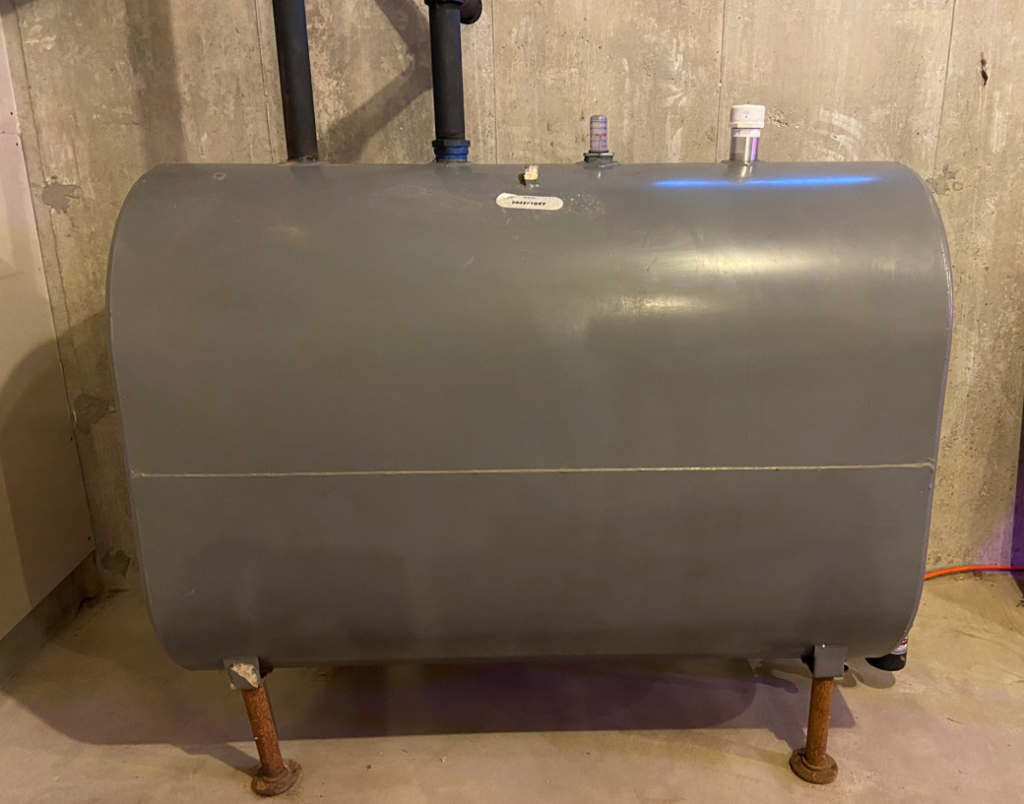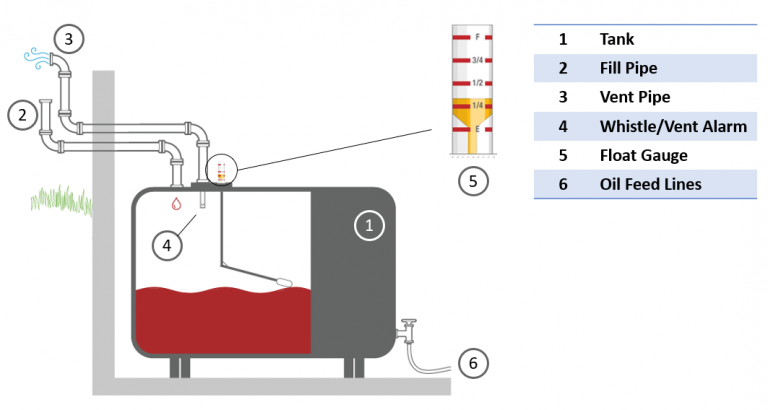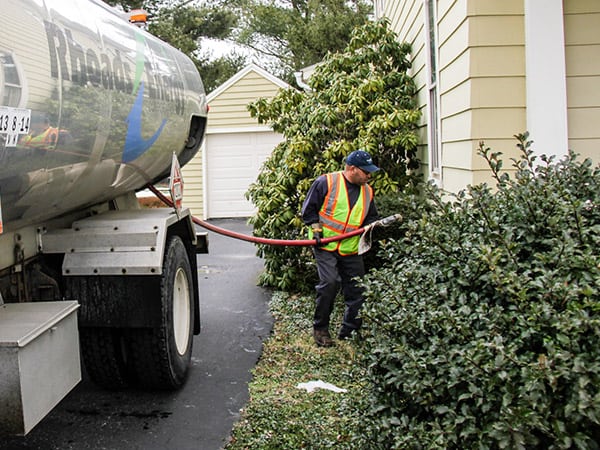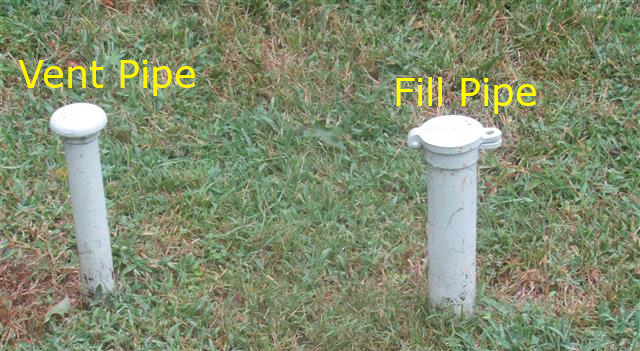If you live in the northeast and use heating oil, you are probably curious as to how they fill your tank. A majority of heating oil tanks are located indoors, but some are still located outdoors. Some indoor tanks are located in hard to get to places such as a crawl space. Now, you might be wondering how the dealer can fill your tank without stepping foot in your home. For dealers to be able to fill your tank, oil tanks must have both a vent pipe and a fill pipe. They are both normally located on the outside of your home, if you have an indoor tank.
In this article, we will explain the various steps of the tank’s filling process. We will also go in-depth about your tank’s various components!

The Heating Oil Tank’s Components
There are a large variety of different types of oil tanks, coming in all shapes and sizes. Most of the time, oil tanks are located inside your home. However, sometimes they are located outside. While some outdoor tanks can even be underground! But, the components in each are all still the same.
Both the fill pipe and the vent pipe extend from the top of the tank. They then go through your exterior wall and position themselves upwards outside. The fill pipe, has an screw able cap that comes off when the tank needs a fill. The vent pipe on the other hand, allows air to escape from the tank during a fill. However, when your tank’s oil level goes down, air enters the tank through the vent as you use oil.
Additionally, oil tanks come with a vent alarm or “whistle”. When it comes to filling your tank, the vent alarm is the most critical component. It is located on the bottom of the vent pipe, and it alerts the dealers when to stop filling. When the tank is getting a fill, the whistle will make a loud noise. It will then become muffled when it’s time to stop pumping. That normally indicates that the tank is full.

How Many Gallons of Oil Should You Order?
Before the dealer can deliver the oil into your tank, they’ll need to know how many gallons to fill. Many customers like to know how many gallons of oil they are getting exactly. Usually you’ll see them order anywhere from 100-200 gallons depending on their tank size. However, some customers like to get a fill up for their tank. When filling up, the dealer will pump oil into the tank until they stop hearing the tank’s whistle. They do this to ensure that the tanks are not getting over filled.
You might be wondering how many gallons of heating oil are in your oil tank. You can keep track of your tanks level from anywhere with the Smart Oil Gauge! This keeps track of your oil level and will inform you when you get a fill or when you’re running low!
Connecting the Fill Pipe and the Hose
After the oil company receives your ticket, they’ll know how many gallons of oil will need to be delivered. After that, they’ll need to locate the fill pipe. The fill pipe is usually always located on the outside of your home. When placing your order for oil, be sure to give them specific instructions on where the fill pipe is located.
Once they know the fill pipe’s location, they will pull the hose all the way towards it. If your driveway is small, the driver might park on the street. They’ll then have to take the hose directly to the fill pipe. However, if you have a larger driveway, the driver might pull in to get closer to it. Once the driver is at the fill pipe’s location, they will unscrew the cap and start pumping!

Pumping Your Tank with Heating Oil
Right after the dealer finds your fill pipe, the driver will start pumping heating oil into your tank. To start the flow of heating oil, the driver must flip a switch on the hose’s nozzle. However, they’ll usually only slightly open the nozzle. This is so that when filling, they can pay attention for the tank’s vent alarm. They do this to ensure that they are not pumping too much into the tank. Doing this will also prevent overflow. If the driver is not careful, the oil tank can overfill very quickly! This is because these oil trucks can pump up to one gallon a second!
Once the driver hears the whistle, they will be able to increase the flow of oil. If the customer orders a specific amount of oil, the dealer will stop filling the tank once they’ve reached that requested amount.
When the customer requests a “fill”, the driver will continue pumping oil into the tank until the whistle sound stops. Once he no longer hears the whistle, we will have to shut the pump off.
Printing Your Order Slip
Whenever the driver is finished with your delivery, he’ll remove the nozzle from the fill pipe and reinstall the cap. The pump is then withdrawn back into the truck where they will prepare your delivery ticket.
The delivery ticket normally includes information such as amount of gallons delivered. While not common, sometimes they will show how many gallons where originally in the tank. There will also be more information such as price per gallon, the date of delivery and more! The information provided varies between dealers.
In-Ground Tanks
These days, in-ground oil tanks are less common than above ground tanks. However, in-ground tanks are still in use in today’s day and age. Unlike above ground tanks, they often don’t have a vent alarm/whistle to inform the driver when the tank is full. To ensure that the driver doesn’t overfill the tank, they will stick measure it before they make the delivery. With the knowledge they get from the stick measurement, they are able to determine how large it is. They will then know how many gallons will be a good amount to deliver.
After the initial measurement, he will pump in a certain amount of oil into the tank. Usually this tends to be around 100 Gallons, and he will then take another measurement. He will then compare the two readings he has from measuring the tank from before, by using a tank chart. Using the tank chart will then help him figure out what size tank he is working with.
However, some drivers will often carry around a vent that’s specifically designed to be inserted into the fill pipe. It functions like a fill pipe that extends down to the top of the in-ground oil tank. The nozzle of the trunk’s hose will be able to thread into this and pump oil through the vented section. At that point, the driver will stop filling the tank.

Conclusion
While most heating oil delivery drivers don’t normally see the tank while they are filling it, they rely on various tools provided by the tank. Such as the vent alarm allowing them to know that they are safely filling the tank.
If you want to see your tank getting filled first hand, next time heating oil is being delivered, see if you are able to observe the driver fill the tank. Most drivers are typically very friendly and are willing to go over the process with you!
Happy Heating,
Hunter



